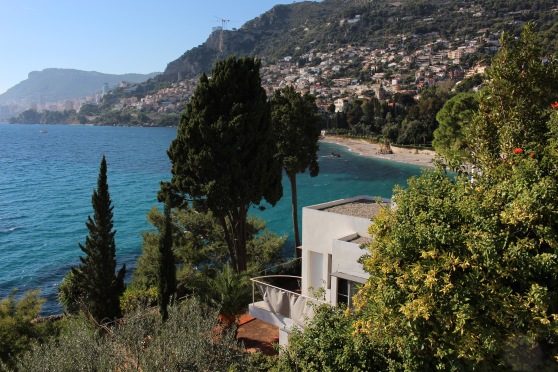 E1027 visited in October 2018
E1027 visited in October 2018
Inside-Out
Like the idea of turning things inside out – using a framework to hang things from and hinge other things to – aiming perhaps for a foldable space, taking away the walls (utter transparency that reminds me of the Farnsworth House and the story that the only functional object Mies van der Rohe left poor Dr Farnsworth when she moved into her glass box was a solitary lightbulb) Linking also to Foucault’s heterotopic ideas about a place withing another place, superimposing one form onto another and with Gray’s way of seeing architecture as a weather and site responsive thing that offers protection from the world – sheltering privacy, providing space to contemplate, party, work and relax.
Project update
Seems like this project has been gestating for a long time – interuptions due to all sorts of real life stuff – anyway the stimulus for the project continues to shift and change and we’ve settled on Eileen Gray, Marianne Brandt, Lilly Reich and Gunta Stolz. There is something appealing about their overall Europeanness – am not sure what I mean by this, but it combines a perhaps utopian view of the future and a desire to create things of considered quality that everyone can have and enjoy (clearly all this was an ideal as much of it was too expensive to produce in an industrialised world) but the intention in many cases was there.
Am becoming more intrigued by these women, their creative lives and their relationships – was relieved to find I am not alone in thinking that the more day-to-day elements of surviving and forming relationships, though perhaps less formal/academic/objective, offer interesting insights into their lives and actually inform us about particular ways of thinking and working that are fundamentally connected to living in the world. Carol Jacobi at the Tate is particularly inspiring when discussing how perhaps male artists have suffered from overly objective and formal discourse focusing on their work rather than an exploration of the relationship between their life and their work, whereas women artists have suffered from being seen as models, muses, pupils, lovers, wives of men and their work viewed as a kind of side show.
Eileen Gray at V&A January 2017
To wander around the 20th Century galleries at the V&A is always a joy – many of the objects manage to look both fresh and yet quite decadant. The work of Eileen Gray on show here manages to look both ! The black laquered screen has silver leaf panels that are surprisingly loosely handled and rough looking, inferring a kind of wabi-sabi approach which probably arose from years of association with lacquer master and collaborator Seizo Sugawara. There is a luxuriant and indulgent quality to some of her work that I don’t find very appealing, but the more pared down designs, like the armchair on display, where the materials are allowed to ‘shine’ are much more exciting. Syrie Maugham’s mirror screen is an intriguing construction of spotted mirrors with multiple bevels, endlessly reflecting the gallery space and offering a fleeting glimpse at a kind of Hollywood glamour in the cold winter light.
Rietveld Schröder House October 2016
Rietveld Schröder House is a surprisingly small house, like a huge and exotic child’s toy set down in a hum-drum suburb. On the guided tour of about 12 people the house shrank further. Downstairs is made up of functional spaces, kitchen, study, hall and the upstairs consists of one large open flexible space that has moveable walls and corner windows that opens right up. Within this more open space there are a few fixed spaces – a loo and Truus Schröder’s bedroom and en suite bathroom. The rooms for her children had moveable walls and it actually proffers a very open and communal way of living, with in places, a dissolution between inside and outside. It has an interesting home-made quality and it’s easy to imagine Reitveld in his workshop on a Saturday morning cutting and painting bits of plywood to create the stark built in furniture. Truus Schröder was instrumental in its design and her aim was to achieve a sense of soberness, because she wanted to live in the active sense and not be lived! She wanted a house without walls and to inhabit a space that was off the ground. When his wife died Reitveld lived here with Truus Schröder.
Watercolours
Collages
Reading
Useful books on modernism, feminism and the history of gendered spaces. Hilde Heynen very good on women’s freedoms in Weimar and how that opened up the way for the idea that modernism itself could be interpreted as a space where women in particular had a place! The Bauhaus however was slow in recognising the contribution women could make and it took some time for them to be accepted across all workshop discplines – weaving for example was seen as women’s work !






















